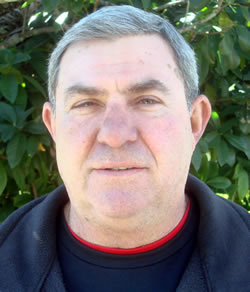Bart Bruni
Level 1 Thermographer #6455
Bestec Home Inspections
323 SE First AvenueHallandale Beach, FL 33009Ph: 954-458-5357www.bestechomeinspections.com
Abstract
As the science of thermography has matured, it has seen increased usage as evidentiary documentation for defects and failures associated with buildings. As experts, qualified thermographers can provide information that is vital to the outcome of a legal claim. This paper will explore three separate cases where thermography was used along with other confirming tools to document termite infestation. It also provides tips for the thermographer as an expert witness.
Introduction
The information age that we currently live in provides the general public with high speed information and it would seem that anyone can become an expert.
We will examine what is necessary for you to be considered a qualified expert acceptable to testify in a court of law, as well as some insight into the world of expert witnessing. The possibility that you may have to testify as an expert witness at some point in your career is very real.
We will briefly review three Pest Management cases and see how technologies such as infrared, digital photos, and other non-destructive test results had an influence on their outcome.
Definitions
Let’s first look at what an expert witness is.
“An expert witness is a witness, who by virtue of education, or profession, or experience, is believed to have special knowledge of his subject beyond that of the average person, sufficient that others may officially (and legally) rely upon his opinion.” (From Wikipedia, 04:39, 14 July 2005)
Types of Experts
 There are several types of experts who often teach as part of their profession. There are Professional experts, Academic experts, Technical experts, Laymen experts and more.
There are several types of experts who often teach as part of their profession. There are Professional experts, Academic experts, Technical experts, Laymen experts and more.
In reality, there is no particular experience or academic degree necessary with the exception that the candidate is at the top of their game in expertise in the field that is relevant to a given case of circumstances or events.
In pest management, entomologists are considered to be the professionals. Professional witnesses such as these are often asked, but rarely accept, the invitation to be an expert witness due in part to a conflict of interest with the companies or institutions that they serve and also because it is too time consuming. Usually, the next choice is a Technical witness defined as one who “has common sense and long life experience and concentrated training in the subject in question”. I have read about another type of witness – “The Dangerous Expert Witness”.
“Good expert witnesses often do very well while testifying except for one or two trick or difficult questions which they are unprepared for or unable to answer and stumble on.” “Dangerous expert witnesses express opinions that hold up under the most rigorous scrutiny and cross-examination.” “Dangerous experts have mastered the techniques for identifying and responding to trick and difficult questions.”
This type of witness understands that their direct examination testimony is probably more important in most cases than their cross-examination testimony. The full understanding of the above is the key to provide your client with the very best service.
The upsides of being an expert witness are the monetary benefits and that you are seen as an expert to whoever cares. The downside is that after both sides put your words under close examination, your professional expertise may be called into question. Therefore, being much like a parachute jump, there is rarely a second chance and little room for error.
“Proof may be necessary to confirm your competency.” “The depth of your knowledge on the given subject will affect the gravity and credibility of one’s testimony.”
Therefore, as an expert witness you may be asked to prepare a list to disclose your qualifications on the subject in question. If you have second thoughts and wish not to be involved in a case any longer, now is the time to get out gracefully. However, if that is not the case, prepare the best list of qualifications that you can.
You can’t have too few or too many qualifications. Just be honest, but try to keep it brief and to the point. Below is an example of what was required to prove my competency in a pest management related case.
Introduction
- Owner and founder of Bestec Exterminators Inc. more than 20 years ago. A full service company on the cutting edge of pest management. Known for his work with exotic varieties of subterranean termites such as Asian/ Formosan Termites, as well as drywood termites and is one of the nation’s leading specialists on treatments and specifications to eliminate these varieties from residential and commercial structures, boats, yachts, and RV’s. As a result, he has received national attention through television, seminars, newsletters and articles.
- Owner and founder of Spectrum Infrared Building Solutions (SIBS) and Bestec Home Inspections.
- Innovator of the first tenting alterative accepted by the Florida Dept. of Agriculture in 1991. As such, created the treatment protocol and wrote the first contractual agreement changing the pest management industry forever. This service provides a viable option to tent fumigation. As a result, borate alterative termite treatment specifications and tenting alternative agreements are now sold all over the world by most pest and termite companies.
- Pioneered Canine Termite inspections for Subterranean and Arboreal Termites in the State of Florida with his famous dog “Tracker”, as seen on TV and in newspapers.
- Designer of “Green Pest Management Strategies”. Since 1991 offering fully organic general household pest control and termite services and all natural botanical service – 100% insecticide free.
- “Small Business Person of the Year 1998”. Personally presented by Governor Jeb Bush.”
Research and Development Studies
- Recognized at the 1998 National Pest Control Convention for his participation in the R&D that helped kick off BAYER Corporation “Premise 75”, the first successful, non-repellent chemistry for subterranean termites. Also, Subterranean Bait Study and Sandy Soil Study. These case studies were published in 1999.
- Participated in 1998 BASF Corporation’s R&D 5 Year Termite Soil Study, Roach insecticide trials. Ant Efficacies Trials, also Subterfuge Termite Bait Trials, as well as participated in research to eradicate the Tree Termite at the EUP site in Dania Beach, Florida, in 2000.
- Participated in 1999 U.S.D.A. funded Termite Bait Study sponsored by FMC Corp. Results were published.
- Joined by invitation the U.S.D.A Tree Termite Eradication Task Force in 2002-2005.
- Began an EUP, R&D 5 year study for Syngenta Corp. via Landis Laboratory Termite Bait Trials and Soil Studies 2004-2008.
- University of Florida Wood Destroying Beetle Survey 2004-2005.
- Served on “The New Orleans Mosquito and Termite National Termite Survey”
- Participating in DuPont Corp. R&D EUP termite soil treatment study 2008-2013.
Certifications
- State Certified Pest Control Operator for 20 years; Cat: GHP, Termite
- Certified Level 1 Thermographer
- Certified Pest Thermographer
Published Papers
- “Three Ways to Use Infrared in Pest Inspections” published in 2004 by FLIR’s Infrared Training division, ITC.
- “The Success or Failure of Infrared Pest Inspections” in 2005 which has been published by Infraspection Institute.
- “The Business of Infrared Home Inspections”, published by Infraspection Institute. 2006
Civic Involvement
- Served six years in the US ARMY and received an honorable discharge.
- Has served on the Board of Directors of the Hallandale Beach Area Chamber of Commerce for many years.
- He is proud to be serving as the Chairman of the Education Committee of the Hallandale Beach Area School District.
Court Experience
- Has served as a professional witness on several wood destroying organism cases, starting in 2003.
These credentials are considered to be sufficient to be a Technical witness for pest management related cases.
Reality of our Legal System
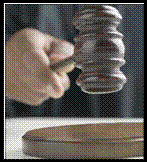 Most cases are won or lost in the discovery phase. When in deposition, one must keep in mind that in most cases there is no sound recording or video running, the court stenographer is the main source of recordkeeping. This limits the record to just what is said and not what is seen, such as body language, how attitudes are expressed, or the volume of one’s voice.
Most cases are won or lost in the discovery phase. When in deposition, one must keep in mind that in most cases there is no sound recording or video running, the court stenographer is the main source of recordkeeping. This limits the record to just what is said and not what is seen, such as body language, how attitudes are expressed, or the volume of one’s voice.
In one case, the opposing attorney was so rude and loud during his attempt to intimidate me that I was forced as a point of order and as a matter of record, to instruct him that “if he did not treat me with respect and common courtesy and stop raising his hands in the air and yelling, I will get up and leave and I would only return if a judge was present to oversee the proceeding.” It worked, he backed off and it went on record.
I have found from my own experience and through my research for this paper that most litigators have this perspective with respect to depositions: “The rules under which a deposition is conducted are much different. There is usually no judge present at a deposition and the grounds for objection are far more limited at deposition than at trial”.
As an expert witness this is a great time to make your point. One could be tempted to walk the thin line between what you can prove and what you cannot fully prove but strongly suspect. Be aware that what you can prove is fact and what you strongly suspect is your expert opinion. Also keep in mind that if the case goes to trail, what you say in your deposition will most likely come up again in the courtroom and you may be required to prove it at that time. Personally, when temptation such as this visits me I have made it a rule to stick to the facts and give my expert opinion only where I feel it will do the most good. When all is said and done, it was your expert opinion that you were paid for.
Compensation
 The compensation is substantial in most cases; you can bill by the hour and don’t forget the travel time. In any case, be prepared to read endless testimony from depositions while being paid by the hour.
The compensation is substantial in most cases; you can bill by the hour and don’t forget the travel time. In any case, be prepared to read endless testimony from depositions while being paid by the hour.
You can use a simple formula such as this to comprise your fees: calculate how many words per minute you are able to read and comprehend. That amount of words per minute times 60 minutes = time per hour times the amount of dollars per hour you charge. Time spent researching can be calculated the same way. The hourly fee is usually less for time spent reading and researching than the time per hour during deposition and when in the courtroom.
If you need some serious direction in being an expert witness or desire to market your expertise may I suggest you start at: http://www.seak.com.
Case Number One
This is a case where a judge called a pest management company out to his home to view some damage that seemed like it could be termite damage. The termite company sent an inspector out to the judge’s plush estate home and the inspector was led to the evidence in question and he positively identified the cause as being a drywood termite infestation. The treatment recommended was tent fumigation. The judge hired the company and they performed a tent fumigation to correct the drywood termite infestation in his home. I believe you will agree that on the surface, this sharing of information and service rendered seem to be reasonably normal and harmless to both parties; however, it was not.
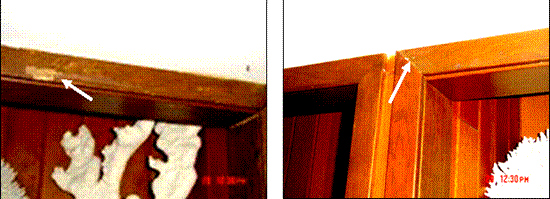
What happened was that many months later, new damage appeared in the same general area were it was discovered the first time. The judge called the company that tented his home for drywood termites and was told by the same inspector that this evidence was subterranean termite damage and was not covered under the current service agreement. The judge argued that this was the same type of damage and evidence that the inspector viewed over a year ago with the exception that more damage occurred. The judge lost faith in the fumigator and canceled his agreement and called a nationally franchised termite company who inspected and treated the judge’s newly-found subterranean termite infestation.
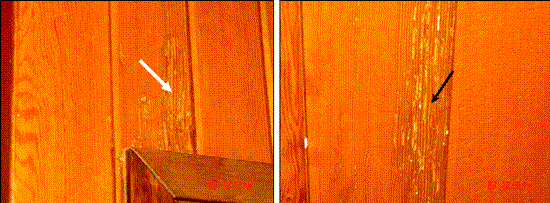
The judge was claiming financial relief from damages sustained from subterranean termites on his home due to a negligent initial termite inspection. The damaged wood was imported and difficult to replace. The suit was for approximately one million dollars.
It was critical for this home to have a complete and visual inspection while being non-destructive, but yet thorough. Infrared imager, motion detector, non-contact laser thermometer, and moisture meter is what was primarily used. These non-destructive technologies provided the data necessary for my deposition in this case.

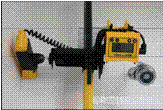 |
Term A Trac microwave motion detector |
Fact #1: There was no current evidence of live subterranean or drywood termites at the time of my inspection. I found more subterranean termite damage that was not recorded, thus increasing the claim. The core of this case was to prove how long it takes for subterranean termites to eat the wood that was undiscovered by the fumigation company and how much did they eat during that period?
This question requires many more questions, such as what type of wood, what was the thickness of the wood, how many termites were involved in the infestation that solely affected the judge’s home, and for how long a period of time were they eating before the second company started their soil treatment and actually corrected the termite infestation, what variety of subterranean was involved, etc.?
I was able to answer all of the above to some degree; however, to have a factual answer for the above question “how much wood was eaten in any given period of time” was predicated on how many termites were involved in the judge’s subterranean termite infestation during the time that they were undiscovered. I used words that would help my client while combating the opposing attorney’s tactics, but at the end of the day I could not honestly tell how many termites were in the infestation that occurred more than a year ago. I gave my opinion as a technical witness.
At best I was a good expert witness, but not a dangerous one. This case may or may not have gone to trial; I was not informed, however, I was paid in full and felt good about what I was able to contribute to this case.
The sad fact in this case is that if the fumigation company had performed a complete and proper visual inspection initially or at very least prior to the fumigation and documented it correctly, there would have been no grounds for a lawsuit.
Case Number Two
I received a call from a young lady living in south Florida in a sizable Townhouse Association. The building design was rustic, including vaulted ceilings, exposed thick wood beams that were integrated components of the roof system, as well as the ceilings. Some exterior walls were wood frame and there was extensive exterior wood trim. There were six units in her cluster.
Most of her neighbors claimed that they had no signs of termites. The Association told her to find an alternative other than fumigation. After having some companies come out and discuss strategies and treatment specifications, she still was not confident that it would work. She found me over the internet. I have been credited with being the innovator of the borate alternative termite service, having had the first patented rights and designing that service in 1991. She asked if I would help with her dilemma.
This case went to a higher authority than the Homeowner’s Association. She had a code violation hearing with the city. She was to be fined $250 per day for not complying with a termite code that, prior to this case, was not being enforced by the city. I agreed to help as a technical witness and we started with a non-destructive inspection of her unit. I could see that the visible signs were supporting the fact that an alternative to fumigation was not going to work. If I could obtain proof the infestation was advanced, it would give substance to this case.
As seen below, visible damage to beams was apparent in many locations. Drywood termite exit holes were plentiful. This is a sign of advanced re-infestation.
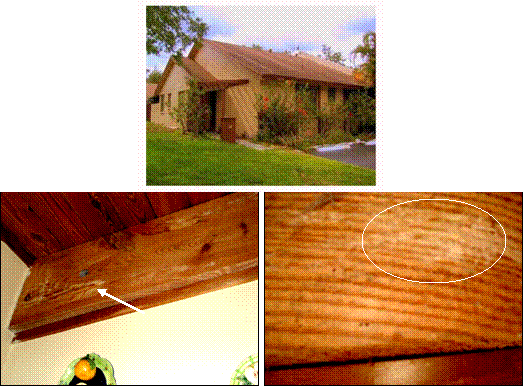

The evidence was overwhelming, given the fact that the presence of wings was proof that the termites had reproductive swarms in her unit. The core fact here is that drywood termite infestations swarm out onto unaffected wood. Then, they mate and start new infestations. The wing evidence of this infestation suggests that it occurred at least two years ago. Thus, the evidence of a new infestation with respect to a new swarm will not appear for at least two years in the future. Subsequently, receptive wood damage occurs to the structure in the process.
Therefore, there is a short window of opportunity (usually two to five years) for an initial infestation when alternatives to fumigation can be used to correct drywood termite infestations. By virtue of the amount of wings found, I knew that this was a mature infestation. The question was “how extensive was the damage to her roof beams and is that damage a viable safety issue”? This was where active thermography was able to provide evidence that proved there was cause for safety concerns.
I did not provide a professional damage report such as you would receive from a structural engineer, nor did I offer any opinions on the damage. However, in my report I was able to provide a reliable visual aid as to how much wood was missing in the roof beams that could be easily comprehended. This allowed the interpretation of “safety” to be evaluated by the city authorities with the least amount of involvement from me. This also had value to the end user because she saved the cost of an engineering report.

The unit owner was heard before a Special Master for code enforcement; the unit owner’s attorney stated that the neighbors and his client had come to “amicably” resolve the issue and presented his case. However, the Special Master was not yet convinced that it was within their jurisdiction to rule on this case. The Special Master chose not to rule on this matter and gave the unit owner 30 days to file a lawsuit against her neighbors to “allow tenting”. Later, this case was sent to a higher authority to rule upon.
My testimony was brief and to the point – my only hope was that the report spoke for itself. Being a hearing and not a trial, there was no cross examination by an opposing attorney. My report was accepted as evidence. The final outcome was that all six unit owners were mandated to evacuate for fumigation. Hence, only my client’s townhouse unit was fumigated with no opposition from the other unit owners or the Homeowner’s Association.
This case set a standard for other townships and cities. Therefore, this case had gotten a lot of publicity. I was quoted by the media (TV, newspapers, internet) and they interviewed other pest control operators in three counties and a well-known entomologist from the University of Florida Research Center. Fortunately, we all agreed with my expert opinion to fumigate when necessary.
The “right to protect your property” was fought for in this case. I have no way of knowing how the local government arrived at the decision. Nevertheless, I think it was the right one and hope that my report had some impact.
Case Number Three
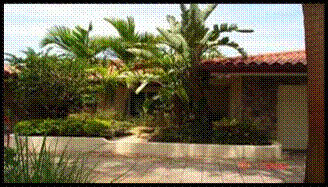 This case started when a young upper middle class family purchased a nice looking and well maintained home in a high end neighborhood.
This case started when a young upper middle class family purchased a nice looking and well maintained home in a high end neighborhood.
After a home inspection by an accredited home inspector, as well as a state certified termite inspection, a national termite company was contracted to prevent and correct any subterranean termite infestation existing or in the future. They backed their service with a one million dollar termite wood damage guarantee. Also, the necessary homeowner’s insurance was purchased by these home buyers, yet this family had a catastrophic ceiling collapse. The ceiling fell in huge sections in their daughter’s bedroom all at once. No one was injured.
It started about one year after they moved in. The homeowner saw some discoloration over her daughter’s bedroom door and called their termite company. A brief inspection was made and she was told that no live termite infestation was present in her home by the termite inspector. So she thought that it might be a leak and called my inspection company. We came out for a leak detection call. In doing so, I used infrared imaging to seek and explore anomalies and found one that presented as a full blown, above ground subterranean termite nest (carton nest). I quantified the anomaly with a moisture meter; it was wet on the hot spot and all around the left upper section of the door frame. The door frame was intact, showing no visible signs of termite damage which is typical. Nonetheless, there was little doubt in my mind that it was a mature carton nest I was looking at in the IR viewer.
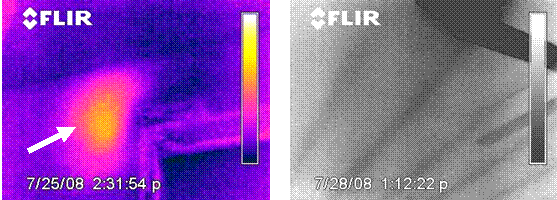
This is an example of a main carton nest signature. At the center of the hot spot over a door frame in the figure to your left, the moisture meter reading was spiking at 30%. The bedroom ceiling appeared normal as we see above in the figure to your right.

The ceiling fell in big sections. The cords of the rafters were like paper. The end photo was where the main nest was removed.
Then, I sent my assistant up in the attic to perform a visual inspection; however, the entry hatch to the attic was not installed in a proper area and would not allow access due to lack of head room necessary to enter. With just a brief inspection, I was reluctant to give the homeowner any more information than just the facts. I asked the homeowners if they would install a hatch for a future inspection and they agreed. At the time of that inspection the facts were that it was not a leak. I could have presumed that she had a subterranean infestation with no proof, but I did not find any live termites yet, and this home was under contract with a termite company of her choice. The only proven fact was that the area above the door was over 30% wet. I was not comfortable suggesting that this home had a live subterranean termite infestation without more evidence. The next day, I received a call from the homeowner – this time at my extermination company. She said that the ceiling collapsed in her daughter’s room and asked if I would come and take a look at her home again – this time for termites.
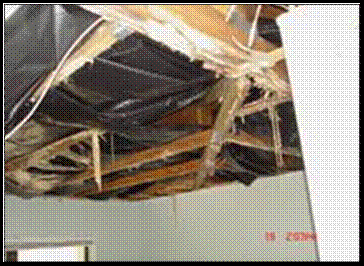 The entire ceiling was gone and now for the first time I could clearly see the attic wood. There was not much left of it, the cords of the rafters in the entire south section of the 3500 square foot home were eaten. This was clearly an Asian subterranean termite infestation, which can consume 3 to 11 pounds of wood per colony per day. I wondered why did I not see this when I looked at the ceiling with my IR camera just a few days ago. Then I realized it was because there were no longer live termites in the attic wood of the south wing, with the exception of the carton nest that I found on my last visit and a small area around that nest.
The entire ceiling was gone and now for the first time I could clearly see the attic wood. There was not much left of it, the cords of the rafters in the entire south section of the 3500 square foot home were eaten. This was clearly an Asian subterranean termite infestation, which can consume 3 to 11 pounds of wood per colony per day. I wondered why did I not see this when I looked at the ceiling with my IR camera just a few days ago. Then I realized it was because there were no longer live termites in the attic wood of the south wing, with the exception of the carton nest that I found on my last visit and a small area around that nest.
It then became obvious why I could not see any temperature change. It was due to the fact that they had eaten the wood and moved on, leaving just dry, devoured wood behind with no detectable thermal signature that would indicate live termites. The north side of the home was equally affected. A total of three live termite carton nests, one main nest and two secondary cartons, were found in the home during my second inspection.
This information caused the homeowners to move out of their home immediately and they required that I provide their attorney with my written report as soon as possible. I spoke with their attorney and he mentioned that the owners had a clause in their homeowner’s insurance policy that provided for coverage if a ceiling collapsed due to insect damage, however, there was a condition. The insured could not be aware that wood destroying organisms were infesting the attic wood. It was apparent to me that they were going after the homeowner’s insurance provider, the termite company, and possibly the seller for damages. I felt bad for the homeowners, but I did the best I could and moved on. A few days later a call came from Mrs. Homeowner. She canceled her agreement with their termite company and wanted my exterminating company to correct her live infestation and keep her home from future attacks. We agreed on a price and I started.
The attorney they hired sought out a professional witness to testify for the claim against their insurance company. He was having a tough time. Asian and Formosan subterranean termites are a very specialized area of pest management and most companies exclude them. They cause billons of dollars in uninsured damage every year over the southern coast of North America.
Their attorney had done some research on me and wanted me to be the technical witness, but since I was hired to treat the home, it would have been a conflict of interest. So, I found myself in the position of expert termite consultant to the attorney that was representing the homeowners.
So, here is a case where I was asked to be a technical witness but could not do so, but inadvertently became an expert consultant to provide the case with necessary termite information that would indeed support the homeowner’s claim.
The insurance company had found an entomologist to be a professional witness but the entomologist was not from south Florida and had little hands-on experience with exotic termites. It was my function to arm their attorney with information about this type of termite and their behavior which would provide him with proof that would hold up in a court of law with respect to how much wood can they eat per day on this home. I was able to establish that 3 to 11 pounds per day was what was being eaten on his home.
I was deposed and paid the normal fee for a witness; my testimony concerned “when did the homeowners find out that they have a live termite infestation in their attic”? That was reasonably easy, the homeowner, to my knowledge, did not know.
The deposition lasted five hours and the opposing attorney was polite but relentless, working always to have me slip up and say “yes, they were privy to the infestation prior to the collapse”. The documentation that was evolved in the treatment of this home was under heavy scrutiny. In this scenario I was not an expert witness – I was just giving testimony, but I felt like a dangerous witness. The opposing attorney was not happy at the end of that proceeding. The homeowners were awarded the claim in this case, and currently are in arbitration proceedings with the national termite company that let their home be eaten down.
This case is one of improper disclosure when the customer purchased their home. The seller hid damage, moved the attic hatch so that no adult could fit and had concealed earth to wood contact on over two thirds of the exterior foundation, thus inviting subterranean termites in to eat the home down.
The national termite company had an arbitration clause in their service agreement. If the homeowners were able to go to a jury trail they would have a much better chance of getting whatever damages they were seeking. This safety net clause leaves the major termite companies with the option not to invest the time and concern to properly inspect each structure every time. This couple was lucky to have this type of homeowner’s insurance policy. These types of polices rarely have any coverage for insect damage, but this one did and the owners were able to receive some financial relief.
This case is still ongoing and the homeowners have not been living in this home for the last two years but are still making the loan payments. My opinion is that if there is anything to learn from this case it is this: when buying property it may pay to go beyond the standard while performing your due diligence. Also, it is generally bad business to sign termite agreements with an arbitration clause.
I was told during my training as a thermographer to report just the facts and be mindful of my opinions. I have found that sometimes that is easier said than done, but I was happy that I did it in this case. If I had not stuck to just the facts in my initial report and suggested that this home did have live termites, my documentation would have hindered their claim. This proves that reporting just the facts works for our customers and for us as inspectors.
Disclaimer
This paper does not provide legal advice applicable to any specific matter and should not be viewed as reliable legal information or be used for that purpose. This paper is intended to provide general information only.
Special thanks to Jim Seffrin for inviting me to write this paper and to Jon Grossman for suggesting the topic.
References: www.seak.com, www.frca.co.uk, kitchen photo, www.vermonttimberworks.com
Visit out Sponsors:
Electrophysics




